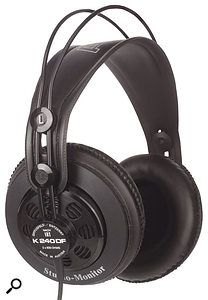 AKG K240 is an open-backed design.Having read Hugh Robjohns' enlightening article 'Mixing On Headphones' in SOS December 2003, I'm considering the purchase of two sets of phones: the AKG K240DF (flat response) for mixing, and the K271 (coloured response) for musicians to wear when monitoring their own signal, giving them the best sound for inspiration and encouragement. Would these models be suitable for these applications?
AKG K240 is an open-backed design.Having read Hugh Robjohns' enlightening article 'Mixing On Headphones' in SOS December 2003, I'm considering the purchase of two sets of phones: the AKG K240DF (flat response) for mixing, and the K271 (coloured response) for musicians to wear when monitoring their own signal, giving them the best sound for inspiration and encouragement. Would these models be suitable for these applications?
Alex Schroeder
Technical Editor Hugh Robjohns replies: I'm not entirely sure I understand quite what you are getting at here in terms of a distinction between headphones with flat and coloured responses. As closed-back headphones go, AKG's K271 headphones are actually pretty uncoloured, with a frequency response that's relatively flat. In any case, I don't personally believe musicians require a deliberately coloured response in their monitoring headphones in order to perform well — just a good loud, clean signal.
Surely the significant difference between these two types of headphones (and their equivalents offered by other manufacturers) is that the K240 is an open-backed design, while the K271 is a closed-back headphone. A closed-back design is absolutely essential if the headphone is to be used to provide a cue feed for the recording musician when overdubbing, to minimise any acoustic spill from the headphone being picked up by the microphone(s). The design of the K271 is also a little unusual in that it incorporates a switch to mute the output when the headphone is not being worn — a very useful feature in a studio full of headphones!
 As closed-back headphones go, AKG's K271 headphones are actually pretty uncoloured, with a frequency response that's relatively flat.It is generally true, however, that most closed-back headphones do tend to sound a little coloured (boxy, even) in comparison with open-backed headphones — and perhaps this is the focal point of your observation. Unfortunately this characteristic is a largely inherent side-effect of the closed-back type of headphone construction. Having said that, though, some of the more recent closed-back designs provide exceptionally good quality, often on a par with the best open-backed designs — Sony's MDR 7509 is one very good example of this technological advance that springs to mind.
As closed-back headphones go, AKG's K271 headphones are actually pretty uncoloured, with a frequency response that's relatively flat.It is generally true, however, that most closed-back headphones do tend to sound a little coloured (boxy, even) in comparison with open-backed headphones — and perhaps this is the focal point of your observation. Unfortunately this characteristic is a largely inherent side-effect of the closed-back type of headphone construction. Having said that, though, some of the more recent closed-back designs provide exceptionally good quality, often on a par with the best open-backed designs — Sony's MDR 7509 is one very good example of this technological advance that springs to mind.
Perhaps the other point to comment on is that your version of the venerable AKG K240 is the DF model (as opposed to the Studio or Monitor versions). These three versions offer broadly the same high-quality performance, but have been optimised for slightly different applications. The original Monitor version has a high-ish 600Ω impedance and a sensitivity of 88dB SPL/mW. In this case, the high impedance is to enable several pairs of headphones to be used in parallel driven from a single power amplifier. The Studio version that followed was re-engineered to provide a lower 55Ω impedance that, combined with a 3dB greater sensitivity (91dB SPL/mW), enables higher sound pressure levels to be achieved from a given power amplifier's output — and hence also required up-rated diaphragms to accommodate the higher peak volumes and wider dynamic range.
The DF version shares the same 88dB SPL/mW sensitivity and construction as the original model, but has been equalised (through design and selection of the drive units) to comply with the IRT's recommendations for delivering a perceived frequency response equivalent to that experienced when listening to reference loudspeakers in a diffuse field situation. In other words, these headphones have been optimised to try to make mixing and signal-processing judgements far more accurate and reliable — something that is notoriously difficult with headphones.
